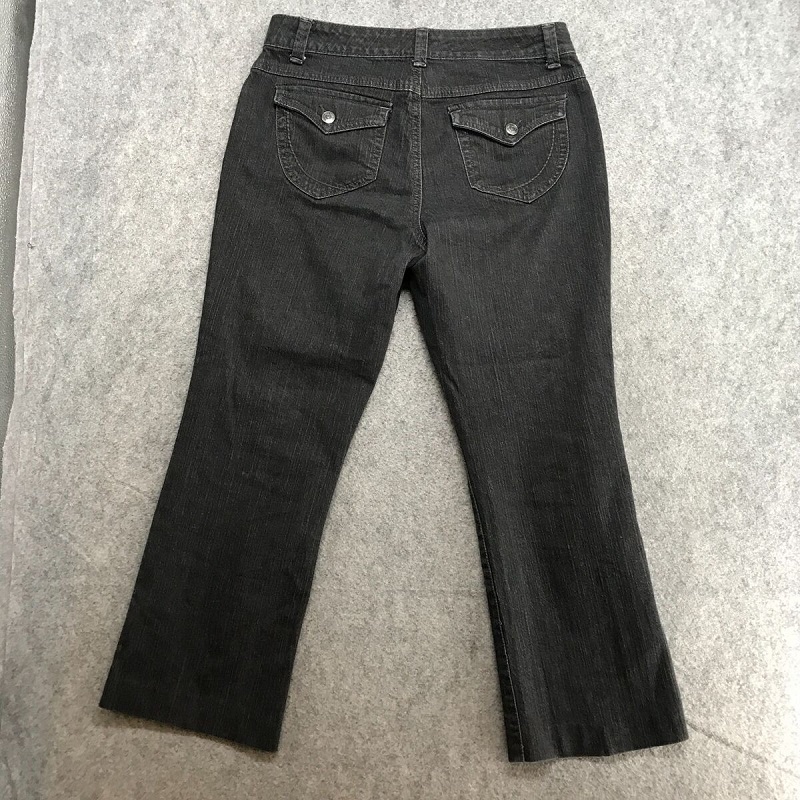Materials Needed for Hemming Your Jeans
How to hem jeans with original hem? To start hemming your jeans while keeping the original hem, you need the right tools. Having proper materials ensures that your DIY project goes smoothly and yields professional-looking results.

Step-by-Step Guide to Gathering Your Hemming Supplies
Once you have your checklist ready, gather all the supplies before you begin. Here’s how to do it efficiently:
- Bring out your jeans and lay them flat to ensure you are working on a clean, level surface.
- Check your sewing machine for compatibility with heavy fabrics and install a heavy-duty needle if needed.
- Match the thread to your jeans by comparing under natural light for the best match.
- Group your pins and clips within reach to hold the fabric folds as you work.
- Sharpen your scissors, or ensure they’re strong enough to cut the denim without fraying the edges.
Gathering your supplies in advance will help streamline your hemming project and minimize interruptions.
Preparing Your Jeans for Hemming
Before diving into the sewing process, preparing your jeans properly is crucial for a successful hem. The prep work involves measuring the jeans to achieve the correct length and pinning them to maintain this length during the sewing process.
Step-by-Step Guide to Measuring and Pinning
To measure and pin your jeans accurately, follow these practical steps:
- Wear the jeans and fold up the excess fabric to the desired length. Have a friend help if necessary.
- Use pins or binder clips to hold the folded fabric in place at the new hemline.
- Remove the jeans carefully and lay them on a flat surface.
- Measure the pinned hem from the fold to the original hem to confirm evenness on both legs.
- Adjust the pins if needed to ensure both legs are even.
By taking the time to measure and pin accurately, you ensure that the new hem will be even and your jeans will fit perfectly after hemming with the original hem.

Sewing the New Hem
Once you have your jeans prepped and pinned, it’s time to start sewing. This stage transforms your jeans to the perfect length while keeping the original hem intact. Sewing the new hem is a straightforward process but requires careful attention to detail to maintain the look of the original finish.
Tips on Stitching Close to the Original Hemline
When stitching the new hem, aim to sew as close to the original hemline as possible. Here are tips to help you achieve that professional look:
- Use a straight stitch setting on your sewing machine. This will create a clean, strong hem.
- Select a thread color that closely matches your jeans. This makes your stitching blend in.
- Begin sewing just below the original hem to preserve its appearance.
- Sew around the leg circumference, ensuring even stitches for durability.
- Take your time and sew slowly to keep your stitch line straight.
- When you reach seams, handle them with care to avoid needle breakage.
By following these steps, you create a new hem that looks almost identical to the original. The sewing part might seem daunting, but with patience and practice, you’ll achieve the desired outcome. Now that you’ve mastered sewing close to the original hemline, the next steps involve trimming and finishing to finalize your new hem.
Trimming and Finishing the Hem
Once you’ve stitched your new hem close to the original, it’s time to trim and finish. Proper trimming and finishing prevent fraying and ensure a clean, tailored look. Handle this step with care to avoid cutting too much off.
Techniques for Cutting and Preventing Fraying
To cut the excess fabric, you need sharp scissors. Cut close to your stitch line, but leave a small edge. Here’s how to do it:
- Put on the jeans to check the hem’s length one last time.
- Remove the jeans, and lay them out flat.
- Carefully cut the excess fabric, leaving about a quarter-inch from the stitches.
- To stop fraying, secure the raw edge. You can use a zigzag stitch or a product like Fray-Check.
- Check that the cut edges are not visible from the outside.
By following these steps, you maintain the integrity of the original hem while achieving a custom fit. Taking your time through this phase is key for a polished end result. So, cut cautiously and finish the edges with attention to detail.
Pressing Your Hemmed Jeans for a Professional Look
After sewing and trimming, pressing is crucial for that crisp, professional look. It sets your hem and gives your jeans a tailored finish.

Ironing Tips for a Crisp Finish
To iron your hemmed jeans perfectly, follow these simple tips:
- Set your iron to the appropriate heat setting for denim.
- Turn the jeans inside out to protect the outer surface.
- Start ironing from the top and work your way down to the hem.
- Press the iron firmly on the new hemline to create a sharp crease.
- Use steam to help flatten tough denim fibers.
- Check the front and back sides for any wrinkles or folds.
Proper pressing not only enhances the look but also helps preserve the stitches. Always iron with care to avoid any heat damage. With these ironing steps, your jeans will maintain a store-bought appearance.
Special Considerations for Hemming Stretch Jeans
When dealing with stretch jeans, a different approach is needed. Stretch jeans often have spandex or other elastic materials that give them flexibility. Hemming them requires techniques that maintain this stretchiness.
How to Hem Jeans Without Affecting the Stretch
To hem stretch jeans and keep the original hem without losing their elasticity, follow these tips:
- Use a zigzag or stretch stitch setting on your sewing machine. This allows the hem to stretch.
- Avoid pulling the fabric while sewing. It prevents puckering and maintains the original shape.
- To match the thread color, pick one that blends with the fabric’s stretch fibers.
- Sew slowly around the hem to ensure the stitches catch the elastic fibers evenly.
- Once done, test the stretch by pulling the hem slightly to ensure it still gives.
Hemming stretch jeans with the original hem requires patience and a gentle touch. Keep the fabric relaxed, and don’t rush the process. This way, you’ll create a hem that not only looks great but also retains the comfort and fit of your stretch jeans.
Post-Hemming: Care and Maintenance
After hemming your jeans, proper care is vital to keep them looking great. Here are straightforward steps to ensure the longevity of your hemmed jeans:
- Wash with care. Turn jeans inside out before washing to protect the new hem.
- Use cold water. This prevents the denim from shrinking and preserves the hem.
- Avoid harsh detergents. Choose mild soaps to prevent wearing out the fabric and stitches.
- Skip the dryer. Air-dry jeans to reduce the risk of shrinkage and fraying.
- Iron when needed. When you must iron, do so on a moderate setting and inside out.
Remember, handling your newly-hemmed jeans gently extends their life and appearance.
Visual Comparison: Before & After Hemming
A visual comparison is a powerful way to see the results of your hemming work. By preserving the original hem, you can compare the modified jeans with their original version and spot the difference – or, ideally, the lack thereof. The goal is to show that your DIY efforts replicate professional tailoring, keeping the authenticity of your jeans intact.

The comparison should reveal:
- The Original Look Maintained: The hem should look untouched aside from the length adjustment.
- Professional Quality: There should be no visible signs of DIY hemming, such as uneven stitching or frayed edges.
- Improved Fit: The jeans should now sit at the right length, particularly when paired with your favorite footwear.
If the jeans have been hemmed correctly, the original hem’s features, like stitching details and wear patterns, will still be part of the jeans’ character. These comparison photos can serve as a testament to how well the method works and give you the confidence to wear your newly hemmed jeans with pride.
